Insulin secretion is attenuated by sympathetic nervous system activity; eg, via exercise. Theoretically,
exercising after a meal should blunt insulin secretion and I don’t
think this will lessen the benefits of exercise, but rather enhance
nutrient partitioning. And this isn’t about the [mythical?]
post-workout “anabolic window.”
Sympathetic innervation of pancreas: norepinephrine –> adrenergic
receptor activation = decreased insulin secretion & increased
lipolysis (Stich et al., 1999):
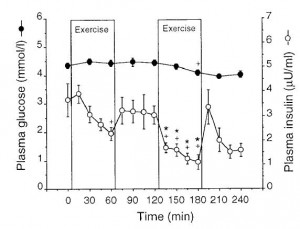
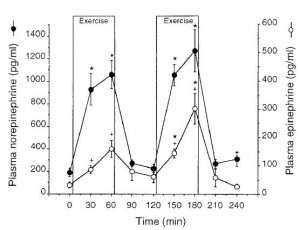
note how quickly catecholamines are cleared upon exercise cessation
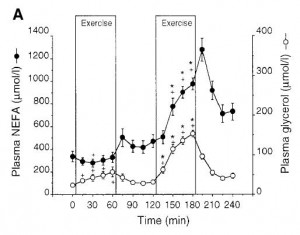
To further
demonstrate the insulin-suppressive effects of exercise, Heesch and
colleagues gave 60 grams of maltodextrin during a 2-hour exercise
session; either during the first half, second half, or all along (evenly
spaced out) (2013):
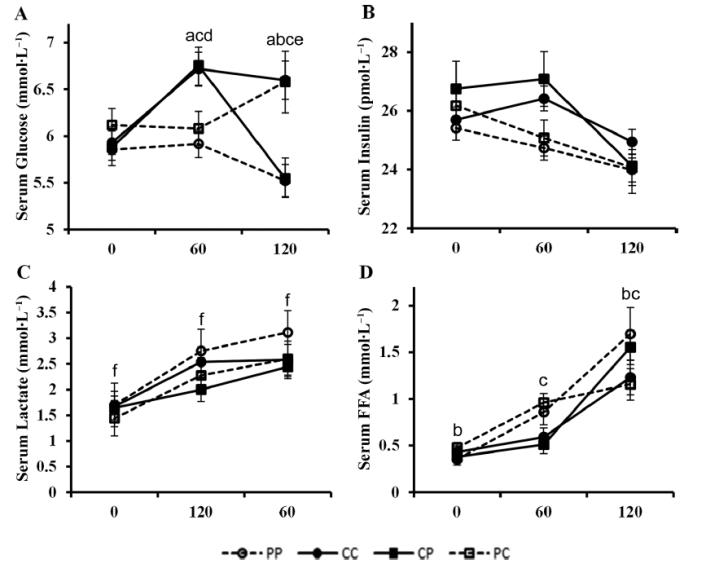
The 4 conditions:
PP: 250 mL flavored water every 15 minutes for 2 hours (placebo group).
CP: 15 grams maltodextrin every 15 minutes for 1st hour, then water for 2nd hour.
PC: water for first hour, 15 grams maltodextrin every 15 minutes during 2nd hour.
CC: 7.5 g maltodextrin every 15 minutes for 2 hours.
Results and interpretation: if you go into this believing in that the
exercise-induced sympathetic nervous system activation suppresses
insulin secretion, then the results were relatively predictable.
PP: blood glucose is low and goes lower. Insulin steadily declines
because: 1) glucose is low; and 2) sympathetic nervous system suppresses
insulin secretion.
CP: blood glucose increases during first half while the participants
are getting maltodextrin, then plummets during second half. Insulin
starts to climb a little in the beginning (due to maltodextrin), then
plummets rapidly as soon as the maltodextrin is done.
PC: glucose starts low when during first half, then climbs during
maltodextrin treatment. Insulin levels decline during first half, but don’t increase during the second half when the participants are getting maltodextrin because sympathetic nervous system is fully activated, suppressing insulin secretion.
CC: glucose only increases in the first half, then starts to decline
in the second half; the dose of maltodextrin isn’t high enough to
overpower exercise-induced insulin suppression and insulin levels just
decline throughout the entire trial.
Exercise blunts insulin secretion; meal timing matters (Tipton et al., 2001).
6 grams essential amino acids
and 35 grams sucrose either immediately before (PRE) or after (POST) a
resistance exercise session consisting of: 10 sets of 8 reps leg press
at 80% 1RM, then 8 sets of 8 reps leg extensions at 80% of 1 RM (2
minutes rest between sets, 45 minutes total).

In PRE, insulin increased 3x; in POST, insulin increased almost 6x. Exercising after the meal nearly cut the insulin spike in half.
In other words, if exercise is performed after the meal, all bets are off; sympathetic nervous system activity is drastically lower… (Costa et al., 2009). Also, see how quickly catecholamines declined when participants stop exercising in the Stich study (above).
Costa 2009: 86 grams maltodextrin and 29 grams soy protein ingested either immediately after or 1 hour after exercise. Full insulin response in both cases.
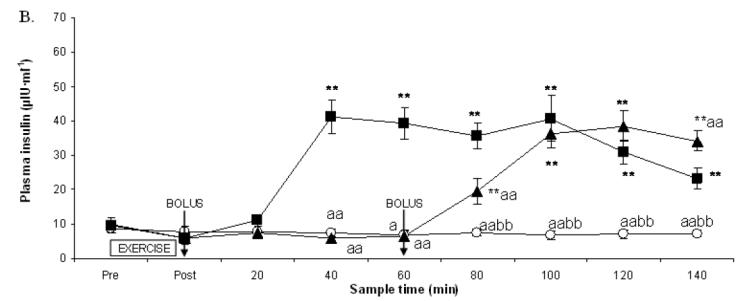
Dietary protein sans exercise can be quite insulinogenic in some contexts (Morifuji et al., 2010)

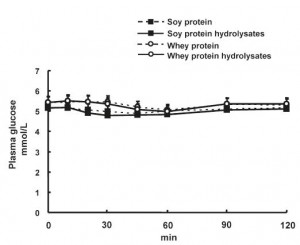
…which is why you might consider exercising afterword. But aren’t
carbs (and insulin) necessary to fully reap the benefits of exercise? Magic 8-Ball says: “My sources say no.” I tend to agree. So do Staples and colleagues (2011):
25 g protein with or without 50 grams carbs, immediately
post-workout. Calories weren’t controlled (on purpose?).
Modest
insulin spike with protein alone, and it doesn’t appear as though the
carb-induced insulin is blunted very much (in relative agreement with Tipton and Costa):
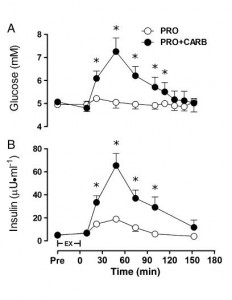
BUT, interestingly, more insulin & calories didn’t translate to
more muscle protein synthesis or less degradation in this study:

This is not an isolated finding:
Coingestion of carbohydrate with protein does not further augment postexercise muscle protein synthesis (Koopman et al., 2007)
Addition of carbohydrates or alanine to an essential amino acid mixture does not enhance human skeletal muscle protein anabolism (Glynn et al., 2013)
Even meals primarily comprised of protein-rich foods stimulate
insulin secretion. To attenuate this and facilitate nutrient
partitioning, I propose exercising afterword.
calories proper
Further reading: Nutrient timing, Op. 101